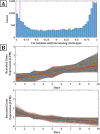This is a preprint.
Transcriptional drift in aging cells: A global de-controller
- PMID: 38045342
- PMCID: PMC10690170
- DOI: 10.1101/2023.11.21.568122
Transcriptional drift in aging cells: A global de-controller
Update in
-
Transcriptional drift in aging cells: A global decontroller.Proc Natl Acad Sci U S A. 2024 Jul 23;121(30):e2401830121. doi: 10.1073/pnas.2401830121. Epub 2024 Jul 16. Proc Natl Acad Sci U S A. 2024. PMID: 39012826 Free PMC article.
Abstract
As cells age, they undergo a remarkable global change: In transcriptional drift, hundreds of genes become overexpressed while hundreds of others become underexpressed. Using archetype modeling and Gene Ontology analysis on data from aging Caenorhabditis elegans worms, we find that the upregulated genes code for sensory proteins upstream of stress responses and downregulated genes are growth- and metabolism-related. We propose a simple mechanistic model for how such global coordination of multi-protein expression levels may be achieved by the binding of a single ligand that concentrates with age. A key implication is that a cell's own responses are part of its aging process, so unlike for wear-and-tear processes, intervention might be able to modulate these effects.
Figures



References
-
- Kirkwood T. B. Understanding the odd science of aging. Cell, 120(4):437–447, 2005. - PubMed
-
- Harper M.-E., Monemdjou S., Ramsey J. J., and Weindruch R. Age-related increase in mitochondrial proton leak and decrease in atp turnover reactions in mouse hepatocytes. American Journal of Physiology-Endocrinology and Metabolism, 275(2):E197–E206, 1998. - PubMed
Publication types
Grants and funding
LinkOut - more resources
Full Text Sources
Research Materials
